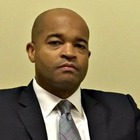Q&A: Enterprise-wide Risk Management Part II
Managing risk accurately and transparently across the entire organization is a huge challenge for all capital markets firms.

Waters gathered together four capital markets sources ─ two representing end-user firms, ANZ and AIA Group ─ and two sponsors ─ Thomson Reuters and GFT ─ to discuss the challenges facing capital markets firms when it comes to designing and implementing enterprise wide-risk management systems. Here are their thoughts...
You can read Part I of this four-part Q&A here.
Q: What are the operational and technology challenges capital markets firms need to consider before they are in a position to manage their risk across the entire enterprise?
Drew Wade, senior managing partner, AIA Group:
While successful boutique hedge funds and smaller trading firms seek out the best and brightest, often when it comes to managing risk, these organizations lack staff with specific IT and operational risk management experience. Firms also  struggle with robust electronic document management systems. Furthermore, risk disclosure documents signed by customers, trading order details, and performance records may not be scanned or backed up.
struggle with robust electronic document management systems. Furthermore, risk disclosure documents signed by customers, trading order details, and performance records may not be scanned or backed up.
Even with the latest cloud-based risk management systems on the market, managers at these firms fail to take advantage of these readily available solutions due to a lack of exposure and limited resources. In some cases, managers may even select a product that ignores the specific need requirements of firms, thereby creating a whole new set of challenges, and in some cases, repetitive tasks become a barrier to growth. A lack of properly selected automation tools for mitigating operational risk becomes an issue.
Ami Grewal, head of business consulting, GFT:
The technological challenges that firms face are almost entirely around the discrete and disparate nature of the systems that exist. Historically, every asset class has its own risk system, for the most part. Suddenly, when you get into enterprise-wide risk, you have to start making everything talk to each other.  Doing that from a systems perspective isn't that terrible; doing it from a data perspective becomes really, really tough. You have different flavors and behaviors of systems, such as the fact that some are talking in XML, some in SOAP, and some in even older languages. Additionally, not only are the system languages different, but the meaning of certain key elements also differs, requiring data normalization and a standard data lexicon. You start mashing these things together and it becomes quite difficult to see the bigger picture.
Doing that from a systems perspective isn't that terrible; doing it from a data perspective becomes really, really tough. You have different flavors and behaviors of systems, such as the fact that some are talking in XML, some in SOAP, and some in even older languages. Additionally, not only are the system languages different, but the meaning of certain key elements also differs, requiring data normalization and a standard data lexicon. You start mashing these things together and it becomes quite difficult to see the bigger picture.
On the operational side, the classic challenge is that you have different risk cut-offs for different businesses that make sense. You start to see operational groups that don't fit together being pushed together because of cost constraints and it may not always make sense.
Suddenly, when you get into enterprise-wide risk, you have to start making everything talk to each other. Doing that from a systems perspective isn't that terrible; doing it from a data perspective becomes really, really tough - Ami Grewal, head of business consulting, GFT.
Marion Leslie, managing director of Thomson Reuters' pricing and reference services business:
For the buy side, firms need to consider building risk assessments into their portfolio construction and management activities to create a better understanding of risks and returns, and to improve overall performance and results. While there 
Both sides of the fence share a common hurdle to instituting an holistic approach to risk management. However, they are often organized by vertical lines of business, creating silos that do not, or cannot, communicate with each other effectively.
Vijay Aviur, head of risk, global markets and wholesale lending technology for ANZ:
Contrary to popular belief, ERM is not as much a solution as it is a framework and a concept. It's a concept whose success largely depends as much on an enterprise's risk appetite and risk culture as it does on its technological and organizational maturity. It's about building a structure and discipline around risk management within the firm.
Achieving operational alignment is key. Many firms struggle with multiple operational challenges that impede successful implementation of an enterprise-wide risk management strategy. These include lack of strong leadership support  and commitment; an insufficient risk-based culture; a poor definition of enterprise risk that leads to poor and inadequate qualitative modeling; a lack of transparency in departmental risk reporting, deviation assessment and monitoring, leading to ineffective senior management oversight; and ever-fluid regulations, which make it difficult to keep up in an organized manner.
and commitment; an insufficient risk-based culture; a poor definition of enterprise risk that leads to poor and inadequate qualitative modeling; a lack of transparency in departmental risk reporting, deviation assessment and monitoring, leading to ineffective senior management oversight; and ever-fluid regulations, which make it difficult to keep up in an organized manner.
Technology alignment is vital. Some of the formidable technology barriers firms contend with while implementing EWRM include: a heterogeneous technology landscape and disparate risk systems; insufficient risk measurement and systems-many risks, even those that are well understood, remain unmeasured due to lack of analytical models, data, staffing and systems integration limitations; insufficient data; and lack of a single product or platform that provides a total solution to enterprise risk management.
Part III of this four-part Q&A will be published on October 9.
Only users who have a paid subscription or are part of a corporate subscription are able to print or copy content.
To access these options, along with all other subscription benefits, please contact info@waterstechnology.com or view our subscription options here: http://subscriptions.waterstechnology.com/subscribe
You are currently unable to print this content. Please contact info@waterstechnology.com to find out more.
You are currently unable to copy this content. Please contact info@waterstechnology.com to find out more.
Copyright Infopro Digital Limited. All rights reserved.
As outlined in our terms and conditions, https://www.infopro-digital.com/terms-and-conditions/subscriptions/ (point 2.4), printing is limited to a single copy.
If you would like to purchase additional rights please email info@waterstechnology.com
Copyright Infopro Digital Limited. All rights reserved.
You may share this content using our article tools. As outlined in our terms and conditions, https://www.infopro-digital.com/terms-and-conditions/subscriptions/ (clause 2.4), an Authorised User may only make one copy of the materials for their own personal use. You must also comply with the restrictions in clause 2.5.
If you would like to purchase additional rights please email info@waterstechnology.com
More on Trading Tech
Artificial intelligence, like a CDO, needs to learn from its mistakes
The IMD Wrap: The value of good data professionals isn’t how many things they’ve got right, says Max Bowie, but how many things they got wrong and then fixed.
Symphony looks to cloud, AI for enhanced trader voice
The communication and collaboration platform provider is utilizing modern technology to grow its network of services and users.
Observations and lessons to learn from the move to T+1
The next few years will see other jurisdictions around the world look to North America for guidance on transitioning to shorter settlement cycles.
As US options market continued its inexorable climb, ‘plumbing’ issues persisted
Capacity concerns have lingered in the options market, but progress was made in 2024.
Doubts raised over new FX platform disclosures
New disclosure sheet template will require platforms to outline how they charge for data
Expanded oversight for tech or a rollback? 2025 set to be big for regulators
From GenAI oversight to DORA and the CAT to off-channel communication, the last 12 months set the stage for larger regulatory conversations in 2025.
DORA flood pitches banks against vendors
Firms ask vendors for late addendums sometimes unrelated to resiliency, requiring renegotiation
IPC’s C-suite shuffle signals bigger changes for trader voice tech
Waters Wrap: After a series of personnel changes at the legacy provider, WatersTechnology examines what these moves might mean for the future of turrets and trader voice.








